Analyzing Cultural Impacts on Organizational Behavior Dynamics
VerifiedAdded on 2023/06/12
|6
|1988
|473
Essay
AI Summary
This essay delves into the significance of cultural dispositions within organizational contexts, particularly in multinational organizations operating across diverse countries. It addresses the challenges arising from cultural conflicts when organizations recruit local employees in new locations to minimize labor costs. The essay explores various organizational conflicts stemming from cultural issues, utilizing hypothetical examples to illustrate the impact on international expansion. It emphasizes the importance of organizational behavior, highlighting the role of managers and employees in navigating cultural differences to avoid performance hindrances. The discussion extends to theories such as inter-group and interpersonal conflict, emphasizing the need for employees to collaborate effectively, respect diverse values, and build healthy relationships to achieve organizational objectives. Ultimately, the essay concludes that organizational behavior is shaped by how employees manage cultural differences, advocating for cultural integration to leverage diverse skills and capacities for organizational success. Desklib offers more solved assignments and resources for students.
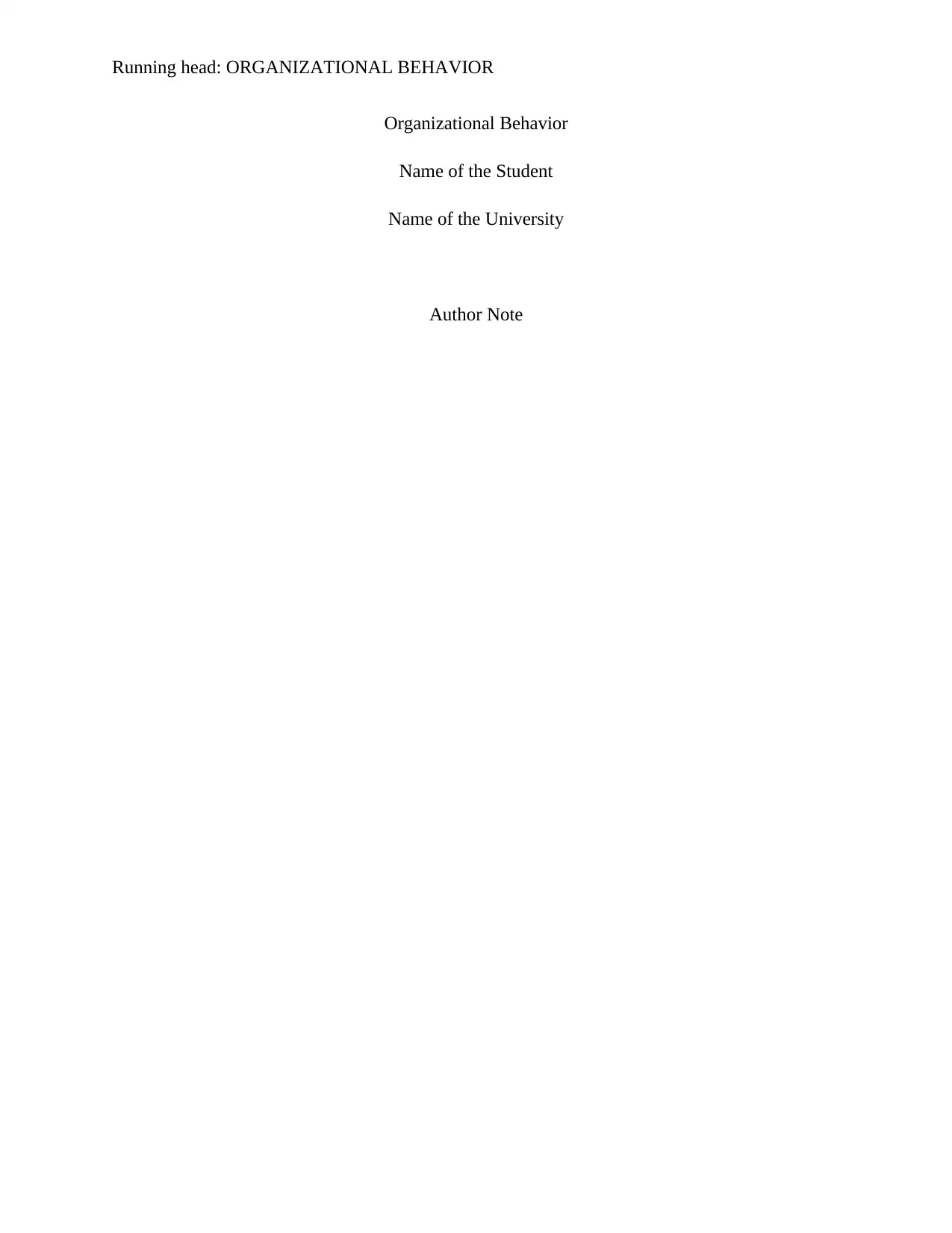
Running head: ORGANIZATIONAL BEHAVIOR
Organizational Behavior
Name of the Student
Name of the University
Author Note
Organizational Behavior
Name of the Student
Name of the University
Author Note
Paraphrase This Document
Need a fresh take? Get an instant paraphrase of this document with our AI Paraphraser
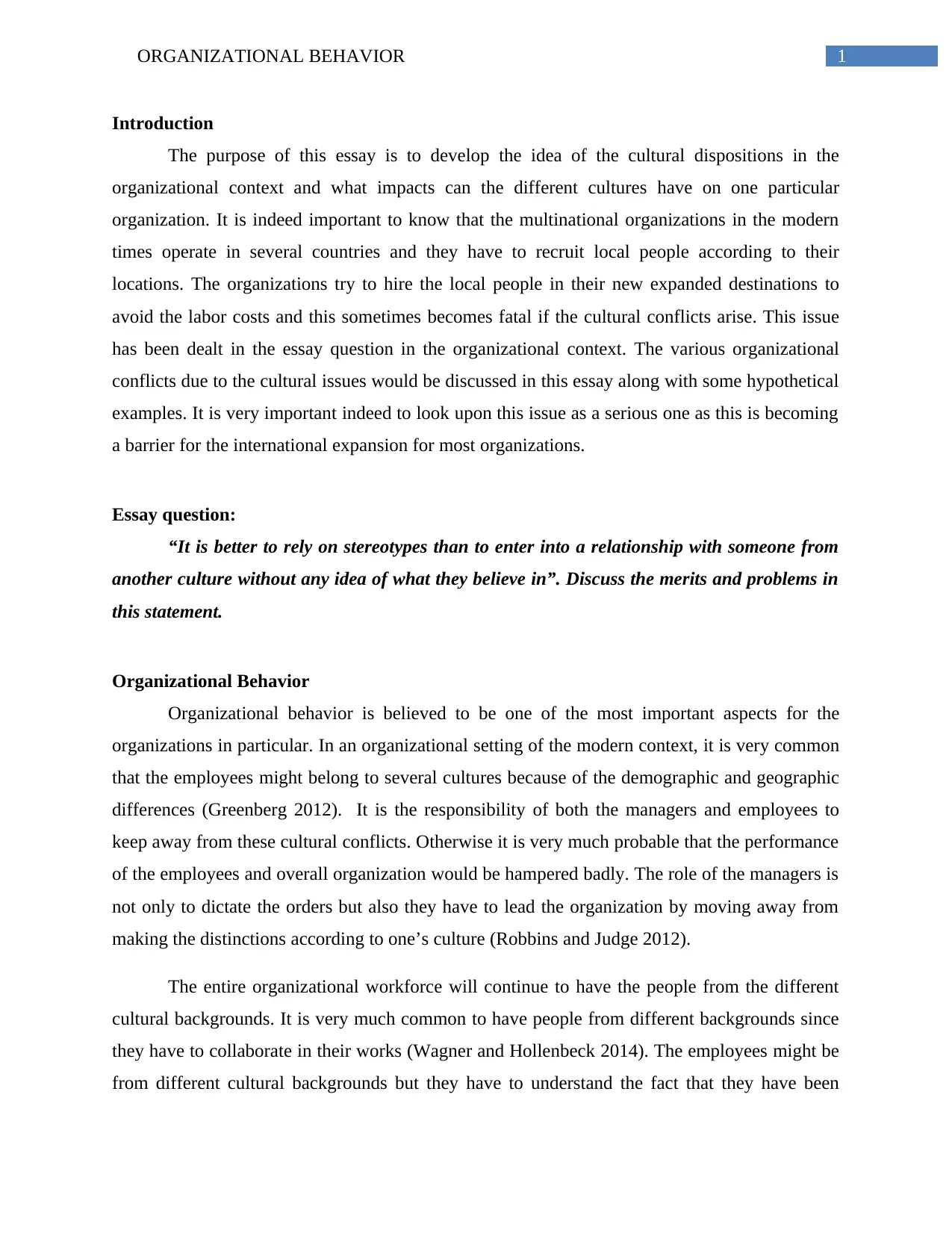
1ORGANIZATIONAL BEHAVIOR
Introduction
The purpose of this essay is to develop the idea of the cultural dispositions in the
organizational context and what impacts can the different cultures have on one particular
organization. It is indeed important to know that the multinational organizations in the modern
times operate in several countries and they have to recruit local people according to their
locations. The organizations try to hire the local people in their new expanded destinations to
avoid the labor costs and this sometimes becomes fatal if the cultural conflicts arise. This issue
has been dealt in the essay question in the organizational context. The various organizational
conflicts due to the cultural issues would be discussed in this essay along with some hypothetical
examples. It is very important indeed to look upon this issue as a serious one as this is becoming
a barrier for the international expansion for most organizations.
Essay question:
“It is better to rely on stereotypes than to enter into a relationship with someone from
another culture without any idea of what they believe in”. Discuss the merits and problems in
this statement.
Organizational Behavior
Organizational behavior is believed to be one of the most important aspects for the
organizations in particular. In an organizational setting of the modern context, it is very common
that the employees might belong to several cultures because of the demographic and geographic
differences (Greenberg 2012). It is the responsibility of both the managers and employees to
keep away from these cultural conflicts. Otherwise it is very much probable that the performance
of the employees and overall organization would be hampered badly. The role of the managers is
not only to dictate the orders but also they have to lead the organization by moving away from
making the distinctions according to one’s culture (Robbins and Judge 2012).
The entire organizational workforce will continue to have the people from the different
cultural backgrounds. It is very much common to have people from different backgrounds since
they have to collaborate in their works (Wagner and Hollenbeck 2014). The employees might be
from different cultural backgrounds but they have to understand the fact that they have been
Introduction
The purpose of this essay is to develop the idea of the cultural dispositions in the
organizational context and what impacts can the different cultures have on one particular
organization. It is indeed important to know that the multinational organizations in the modern
times operate in several countries and they have to recruit local people according to their
locations. The organizations try to hire the local people in their new expanded destinations to
avoid the labor costs and this sometimes becomes fatal if the cultural conflicts arise. This issue
has been dealt in the essay question in the organizational context. The various organizational
conflicts due to the cultural issues would be discussed in this essay along with some hypothetical
examples. It is very important indeed to look upon this issue as a serious one as this is becoming
a barrier for the international expansion for most organizations.
Essay question:
“It is better to rely on stereotypes than to enter into a relationship with someone from
another culture without any idea of what they believe in”. Discuss the merits and problems in
this statement.
Organizational Behavior
Organizational behavior is believed to be one of the most important aspects for the
organizations in particular. In an organizational setting of the modern context, it is very common
that the employees might belong to several cultures because of the demographic and geographic
differences (Greenberg 2012). It is the responsibility of both the managers and employees to
keep away from these cultural conflicts. Otherwise it is very much probable that the performance
of the employees and overall organization would be hampered badly. The role of the managers is
not only to dictate the orders but also they have to lead the organization by moving away from
making the distinctions according to one’s culture (Robbins and Judge 2012).
The entire organizational workforce will continue to have the people from the different
cultural backgrounds. It is very much common to have people from different backgrounds since
they have to collaborate in their works (Wagner and Hollenbeck 2014). The employees might be
from different cultural backgrounds but they have to understand the fact that they have been
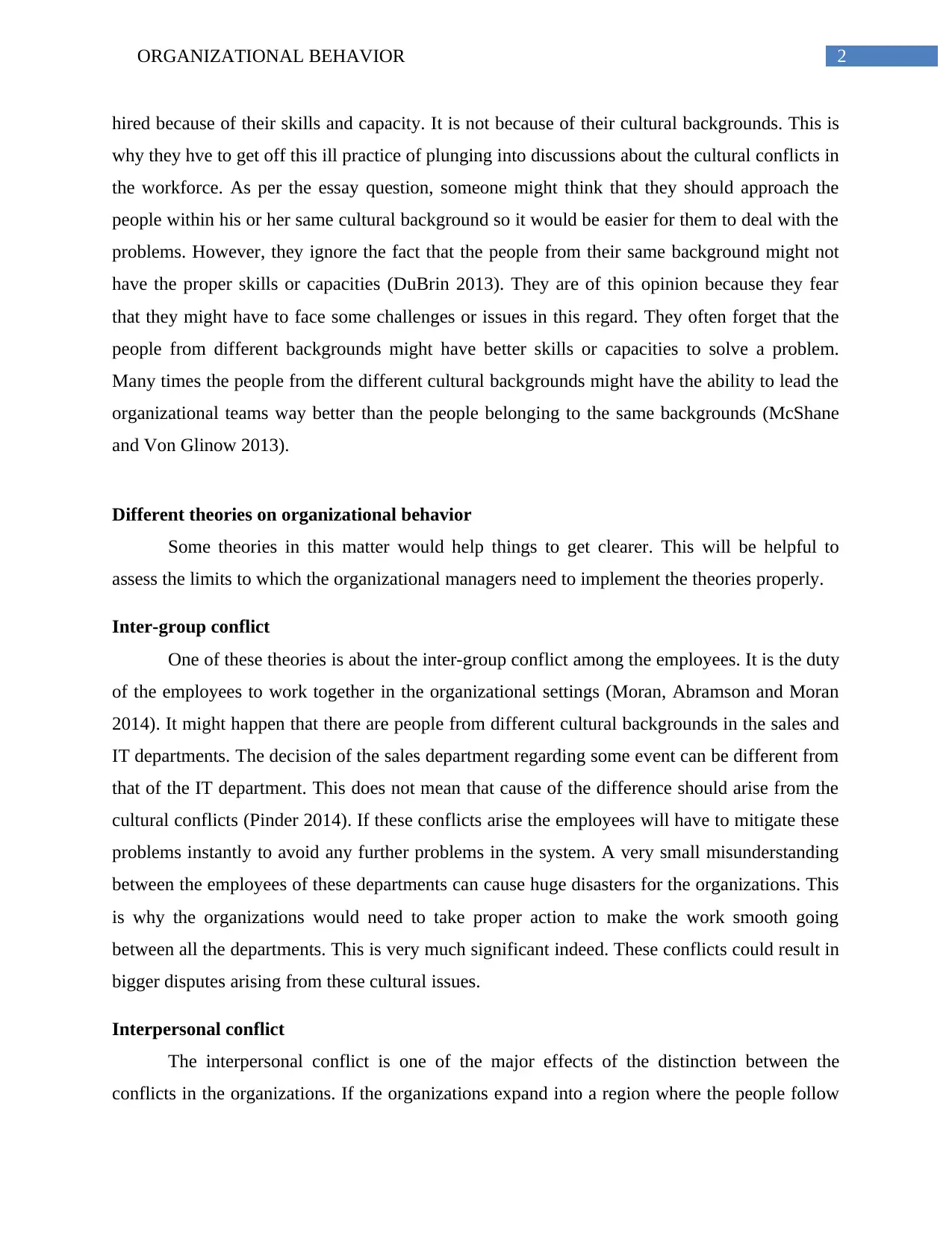
2ORGANIZATIONAL BEHAVIOR
hired because of their skills and capacity. It is not because of their cultural backgrounds. This is
why they hve to get off this ill practice of plunging into discussions about the cultural conflicts in
the workforce. As per the essay question, someone might think that they should approach the
people within his or her same cultural background so it would be easier for them to deal with the
problems. However, they ignore the fact that the people from their same background might not
have the proper skills or capacities (DuBrin 2013). They are of this opinion because they fear
that they might have to face some challenges or issues in this regard. They often forget that the
people from different backgrounds might have better skills or capacities to solve a problem.
Many times the people from the different cultural backgrounds might have the ability to lead the
organizational teams way better than the people belonging to the same backgrounds (McShane
and Von Glinow 2013).
Different theories on organizational behavior
Some theories in this matter would help things to get clearer. This will be helpful to
assess the limits to which the organizational managers need to implement the theories properly.
Inter-group conflict
One of these theories is about the inter-group conflict among the employees. It is the duty
of the employees to work together in the organizational settings (Moran, Abramson and Moran
2014). It might happen that there are people from different cultural backgrounds in the sales and
IT departments. The decision of the sales department regarding some event can be different from
that of the IT department. This does not mean that cause of the difference should arise from the
cultural conflicts (Pinder 2014). If these conflicts arise the employees will have to mitigate these
problems instantly to avoid any further problems in the system. A very small misunderstanding
between the employees of these departments can cause huge disasters for the organizations. This
is why the organizations would need to take proper action to make the work smooth going
between all the departments. This is very much significant indeed. These conflicts could result in
bigger disputes arising from these cultural issues.
Interpersonal conflict
The interpersonal conflict is one of the major effects of the distinction between the
conflicts in the organizations. If the organizations expand into a region where the people follow
hired because of their skills and capacity. It is not because of their cultural backgrounds. This is
why they hve to get off this ill practice of plunging into discussions about the cultural conflicts in
the workforce. As per the essay question, someone might think that they should approach the
people within his or her same cultural background so it would be easier for them to deal with the
problems. However, they ignore the fact that the people from their same background might not
have the proper skills or capacities (DuBrin 2013). They are of this opinion because they fear
that they might have to face some challenges or issues in this regard. They often forget that the
people from different backgrounds might have better skills or capacities to solve a problem.
Many times the people from the different cultural backgrounds might have the ability to lead the
organizational teams way better than the people belonging to the same backgrounds (McShane
and Von Glinow 2013).
Different theories on organizational behavior
Some theories in this matter would help things to get clearer. This will be helpful to
assess the limits to which the organizational managers need to implement the theories properly.
Inter-group conflict
One of these theories is about the inter-group conflict among the employees. It is the duty
of the employees to work together in the organizational settings (Moran, Abramson and Moran
2014). It might happen that there are people from different cultural backgrounds in the sales and
IT departments. The decision of the sales department regarding some event can be different from
that of the IT department. This does not mean that cause of the difference should arise from the
cultural conflicts (Pinder 2014). If these conflicts arise the employees will have to mitigate these
problems instantly to avoid any further problems in the system. A very small misunderstanding
between the employees of these departments can cause huge disasters for the organizations. This
is why the organizations would need to take proper action to make the work smooth going
between all the departments. This is very much significant indeed. These conflicts could result in
bigger disputes arising from these cultural issues.
Interpersonal conflict
The interpersonal conflict is one of the major effects of the distinction between the
conflicts in the organizations. If the organizations expand into a region where the people follow
⊘ This is a preview!⊘
Do you want full access?
Subscribe today to unlock all pages.

Trusted by 1+ million students worldwide
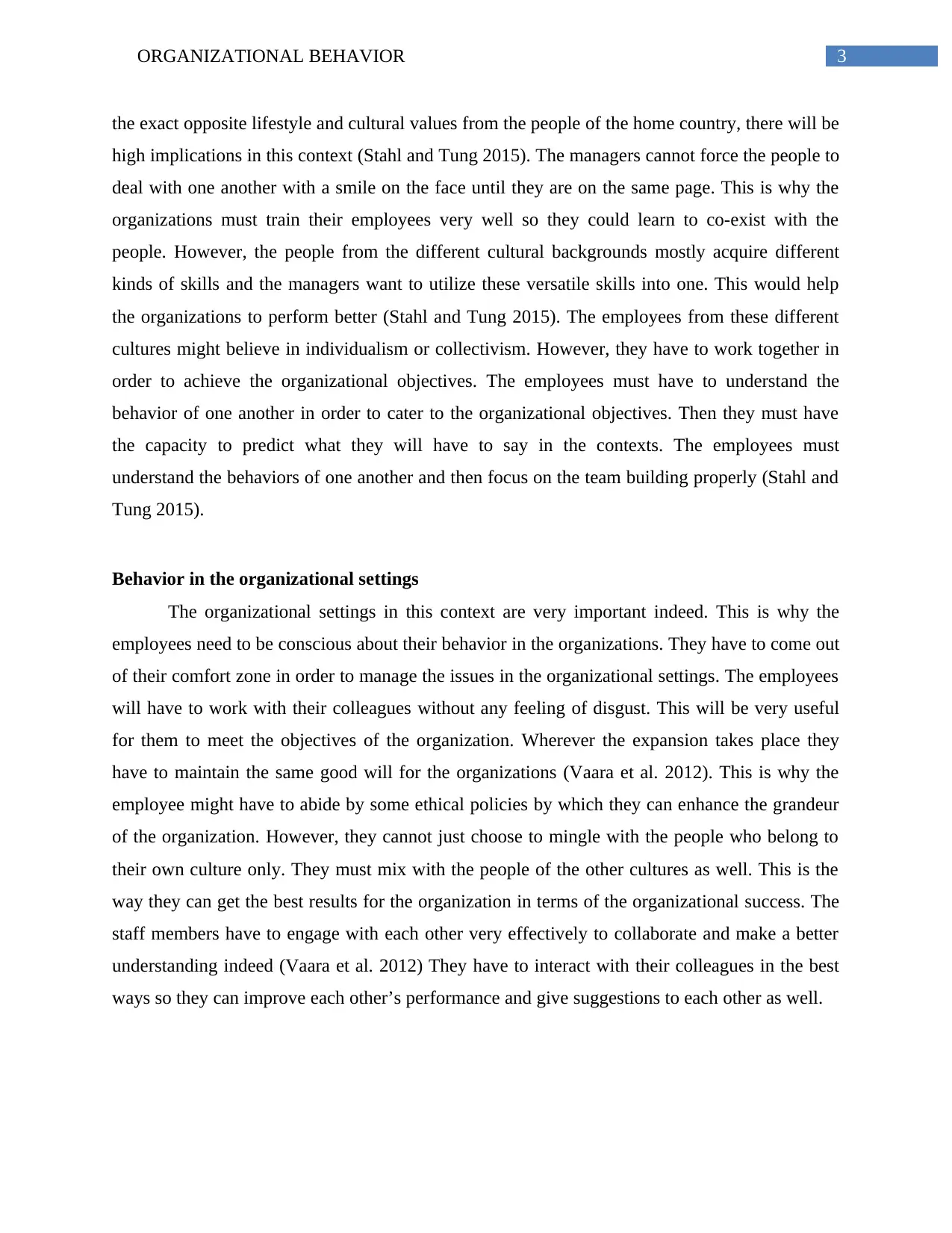
3ORGANIZATIONAL BEHAVIOR
the exact opposite lifestyle and cultural values from the people of the home country, there will be
high implications in this context (Stahl and Tung 2015). The managers cannot force the people to
deal with one another with a smile on the face until they are on the same page. This is why the
organizations must train their employees very well so they could learn to co-exist with the
people. However, the people from the different cultural backgrounds mostly acquire different
kinds of skills and the managers want to utilize these versatile skills into one. This would help
the organizations to perform better (Stahl and Tung 2015). The employees from these different
cultures might believe in individualism or collectivism. However, they have to work together in
order to achieve the organizational objectives. The employees must have to understand the
behavior of one another in order to cater to the organizational objectives. Then they must have
the capacity to predict what they will have to say in the contexts. The employees must
understand the behaviors of one another and then focus on the team building properly (Stahl and
Tung 2015).
Behavior in the organizational settings
The organizational settings in this context are very important indeed. This is why the
employees need to be conscious about their behavior in the organizations. They have to come out
of their comfort zone in order to manage the issues in the organizational settings. The employees
will have to work with their colleagues without any feeling of disgust. This will be very useful
for them to meet the objectives of the organization. Wherever the expansion takes place they
have to maintain the same good will for the organizations (Vaara et al. 2012). This is why the
employee might have to abide by some ethical policies by which they can enhance the grandeur
of the organization. However, they cannot just choose to mingle with the people who belong to
their own culture only. They must mix with the people of the other cultures as well. This is the
way they can get the best results for the organization in terms of the organizational success. The
staff members have to engage with each other very effectively to collaborate and make a better
understanding indeed (Vaara et al. 2012) They have to interact with their colleagues in the best
ways so they can improve each other’s performance and give suggestions to each other as well.
the exact opposite lifestyle and cultural values from the people of the home country, there will be
high implications in this context (Stahl and Tung 2015). The managers cannot force the people to
deal with one another with a smile on the face until they are on the same page. This is why the
organizations must train their employees very well so they could learn to co-exist with the
people. However, the people from the different cultural backgrounds mostly acquire different
kinds of skills and the managers want to utilize these versatile skills into one. This would help
the organizations to perform better (Stahl and Tung 2015). The employees from these different
cultures might believe in individualism or collectivism. However, they have to work together in
order to achieve the organizational objectives. The employees must have to understand the
behavior of one another in order to cater to the organizational objectives. Then they must have
the capacity to predict what they will have to say in the contexts. The employees must
understand the behaviors of one another and then focus on the team building properly (Stahl and
Tung 2015).
Behavior in the organizational settings
The organizational settings in this context are very important indeed. This is why the
employees need to be conscious about their behavior in the organizations. They have to come out
of their comfort zone in order to manage the issues in the organizational settings. The employees
will have to work with their colleagues without any feeling of disgust. This will be very useful
for them to meet the objectives of the organization. Wherever the expansion takes place they
have to maintain the same good will for the organizations (Vaara et al. 2012). This is why the
employee might have to abide by some ethical policies by which they can enhance the grandeur
of the organization. However, they cannot just choose to mingle with the people who belong to
their own culture only. They must mix with the people of the other cultures as well. This is the
way they can get the best results for the organization in terms of the organizational success. The
staff members have to engage with each other very effectively to collaborate and make a better
understanding indeed (Vaara et al. 2012) They have to interact with their colleagues in the best
ways so they can improve each other’s performance and give suggestions to each other as well.
Paraphrase This Document
Need a fresh take? Get an instant paraphrase of this document with our AI Paraphraser
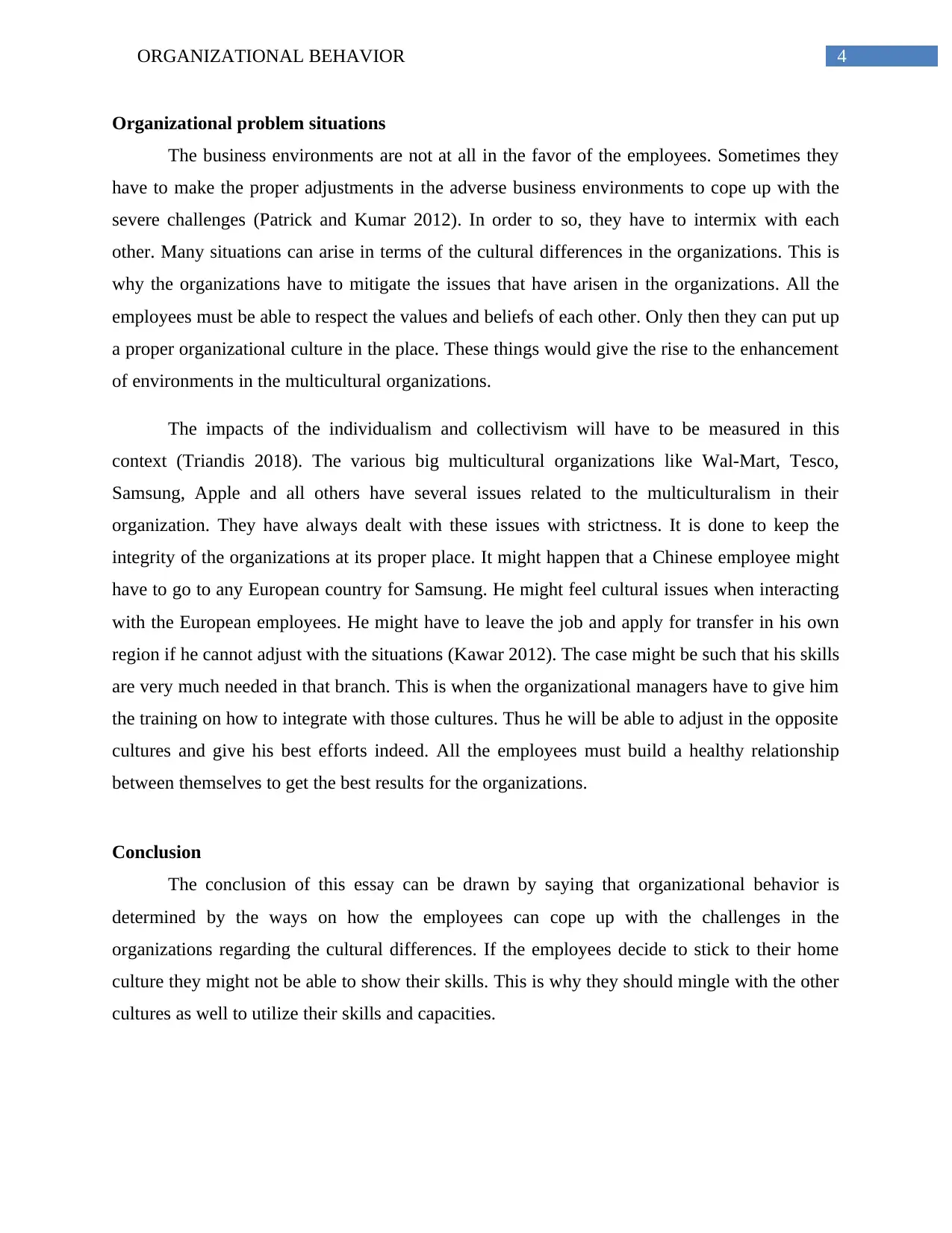
4ORGANIZATIONAL BEHAVIOR
Organizational problem situations
The business environments are not at all in the favor of the employees. Sometimes they
have to make the proper adjustments in the adverse business environments to cope up with the
severe challenges (Patrick and Kumar 2012). In order to so, they have to intermix with each
other. Many situations can arise in terms of the cultural differences in the organizations. This is
why the organizations have to mitigate the issues that have arisen in the organizations. All the
employees must be able to respect the values and beliefs of each other. Only then they can put up
a proper organizational culture in the place. These things would give the rise to the enhancement
of environments in the multicultural organizations.
The impacts of the individualism and collectivism will have to be measured in this
context (Triandis 2018). The various big multicultural organizations like Wal-Mart, Tesco,
Samsung, Apple and all others have several issues related to the multiculturalism in their
organization. They have always dealt with these issues with strictness. It is done to keep the
integrity of the organizations at its proper place. It might happen that a Chinese employee might
have to go to any European country for Samsung. He might feel cultural issues when interacting
with the European employees. He might have to leave the job and apply for transfer in his own
region if he cannot adjust with the situations (Kawar 2012). The case might be such that his skills
are very much needed in that branch. This is when the organizational managers have to give him
the training on how to integrate with those cultures. Thus he will be able to adjust in the opposite
cultures and give his best efforts indeed. All the employees must build a healthy relationship
between themselves to get the best results for the organizations.
Conclusion
The conclusion of this essay can be drawn by saying that organizational behavior is
determined by the ways on how the employees can cope up with the challenges in the
organizations regarding the cultural differences. If the employees decide to stick to their home
culture they might not be able to show their skills. This is why they should mingle with the other
cultures as well to utilize their skills and capacities.
Organizational problem situations
The business environments are not at all in the favor of the employees. Sometimes they
have to make the proper adjustments in the adverse business environments to cope up with the
severe challenges (Patrick and Kumar 2012). In order to so, they have to intermix with each
other. Many situations can arise in terms of the cultural differences in the organizations. This is
why the organizations have to mitigate the issues that have arisen in the organizations. All the
employees must be able to respect the values and beliefs of each other. Only then they can put up
a proper organizational culture in the place. These things would give the rise to the enhancement
of environments in the multicultural organizations.
The impacts of the individualism and collectivism will have to be measured in this
context (Triandis 2018). The various big multicultural organizations like Wal-Mart, Tesco,
Samsung, Apple and all others have several issues related to the multiculturalism in their
organization. They have always dealt with these issues with strictness. It is done to keep the
integrity of the organizations at its proper place. It might happen that a Chinese employee might
have to go to any European country for Samsung. He might feel cultural issues when interacting
with the European employees. He might have to leave the job and apply for transfer in his own
region if he cannot adjust with the situations (Kawar 2012). The case might be such that his skills
are very much needed in that branch. This is when the organizational managers have to give him
the training on how to integrate with those cultures. Thus he will be able to adjust in the opposite
cultures and give his best efforts indeed. All the employees must build a healthy relationship
between themselves to get the best results for the organizations.
Conclusion
The conclusion of this essay can be drawn by saying that organizational behavior is
determined by the ways on how the employees can cope up with the challenges in the
organizations regarding the cultural differences. If the employees decide to stick to their home
culture they might not be able to show their skills. This is why they should mingle with the other
cultures as well to utilize their skills and capacities.
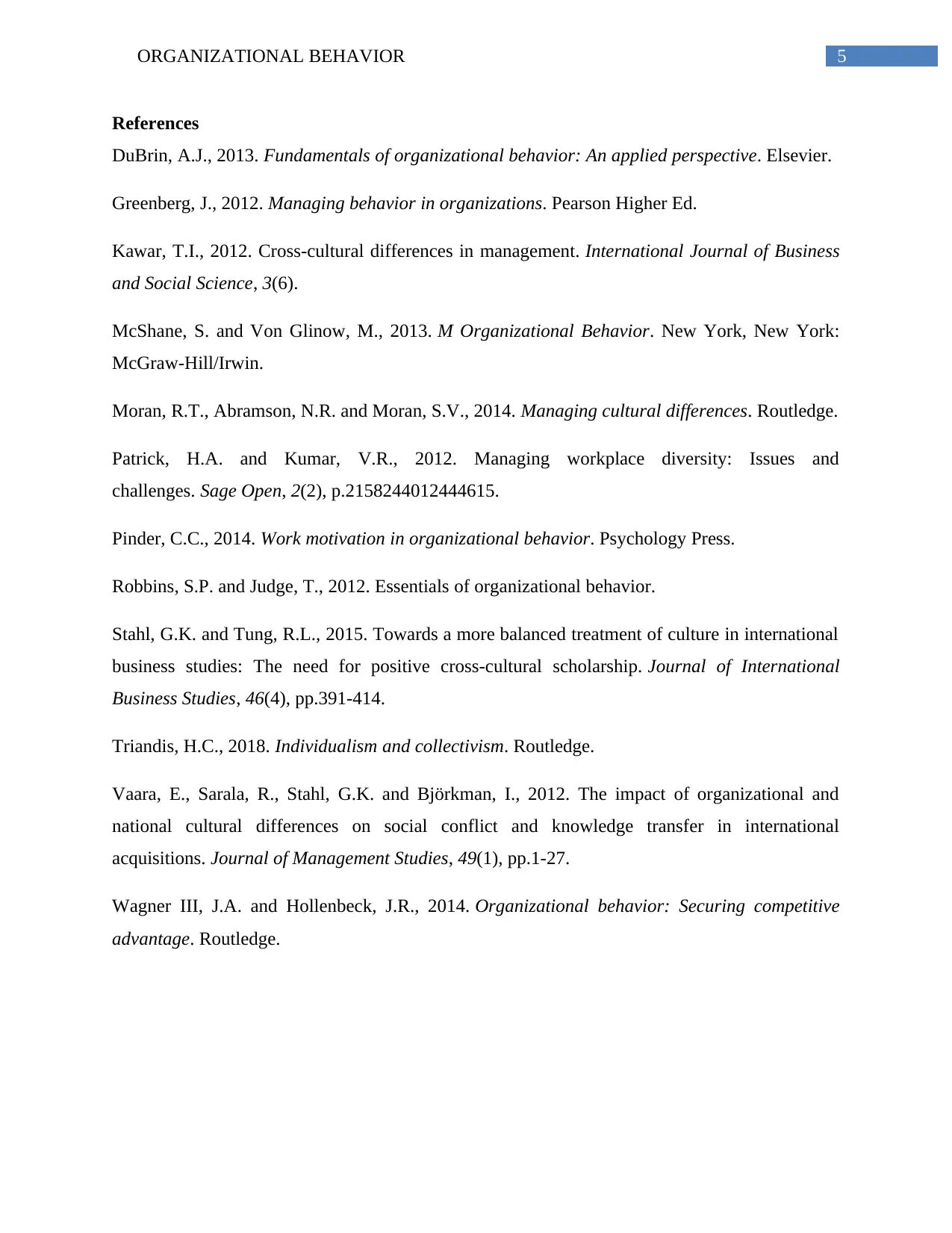
5ORGANIZATIONAL BEHAVIOR
References
DuBrin, A.J., 2013. Fundamentals of organizational behavior: An applied perspective. Elsevier.
Greenberg, J., 2012. Managing behavior in organizations. Pearson Higher Ed.
Kawar, T.I., 2012. Cross-cultural differences in management. International Journal of Business
and Social Science, 3(6).
McShane, S. and Von Glinow, M., 2013. M Organizational Behavior. New York, New York:
McGraw-Hill/Irwin.
Moran, R.T., Abramson, N.R. and Moran, S.V., 2014. Managing cultural differences. Routledge.
Patrick, H.A. and Kumar, V.R., 2012. Managing workplace diversity: Issues and
challenges. Sage Open, 2(2), p.2158244012444615.
Pinder, C.C., 2014. Work motivation in organizational behavior. Psychology Press.
Robbins, S.P. and Judge, T., 2012. Essentials of organizational behavior.
Stahl, G.K. and Tung, R.L., 2015. Towards a more balanced treatment of culture in international
business studies: The need for positive cross-cultural scholarship. Journal of International
Business Studies, 46(4), pp.391-414.
Triandis, H.C., 2018. Individualism and collectivism. Routledge.
Vaara, E., Sarala, R., Stahl, G.K. and Björkman, I., 2012. The impact of organizational and
national cultural differences on social conflict and knowledge transfer in international
acquisitions. Journal of Management Studies, 49(1), pp.1-27.
Wagner III, J.A. and Hollenbeck, J.R., 2014. Organizational behavior: Securing competitive
advantage. Routledge.
References
DuBrin, A.J., 2013. Fundamentals of organizational behavior: An applied perspective. Elsevier.
Greenberg, J., 2012. Managing behavior in organizations. Pearson Higher Ed.
Kawar, T.I., 2012. Cross-cultural differences in management. International Journal of Business
and Social Science, 3(6).
McShane, S. and Von Glinow, M., 2013. M Organizational Behavior. New York, New York:
McGraw-Hill/Irwin.
Moran, R.T., Abramson, N.R. and Moran, S.V., 2014. Managing cultural differences. Routledge.
Patrick, H.A. and Kumar, V.R., 2012. Managing workplace diversity: Issues and
challenges. Sage Open, 2(2), p.2158244012444615.
Pinder, C.C., 2014. Work motivation in organizational behavior. Psychology Press.
Robbins, S.P. and Judge, T., 2012. Essentials of organizational behavior.
Stahl, G.K. and Tung, R.L., 2015. Towards a more balanced treatment of culture in international
business studies: The need for positive cross-cultural scholarship. Journal of International
Business Studies, 46(4), pp.391-414.
Triandis, H.C., 2018. Individualism and collectivism. Routledge.
Vaara, E., Sarala, R., Stahl, G.K. and Björkman, I., 2012. The impact of organizational and
national cultural differences on social conflict and knowledge transfer in international
acquisitions. Journal of Management Studies, 49(1), pp.1-27.
Wagner III, J.A. and Hollenbeck, J.R., 2014. Organizational behavior: Securing competitive
advantage. Routledge.
⊘ This is a preview!⊘
Do you want full access?
Subscribe today to unlock all pages.

Trusted by 1+ million students worldwide
1 out of 6
Related Documents
Your All-in-One AI-Powered Toolkit for Academic Success.
+13062052269
info@desklib.com
Available 24*7 on WhatsApp / Email
![[object Object]](/_next/static/media/star-bottom.7253800d.svg)
Unlock your academic potential
Copyright © 2020–2025 A2Z Services. All Rights Reserved. Developed and managed by ZUCOL.





